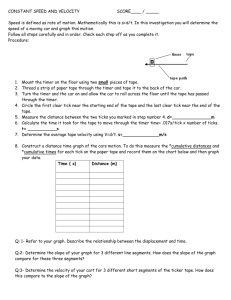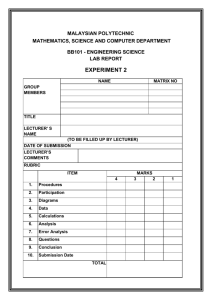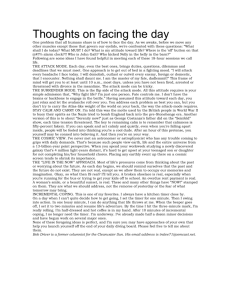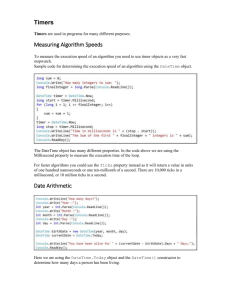Uniform Motion Lab - Saskatchewan Learning - Physics 30
advertisement
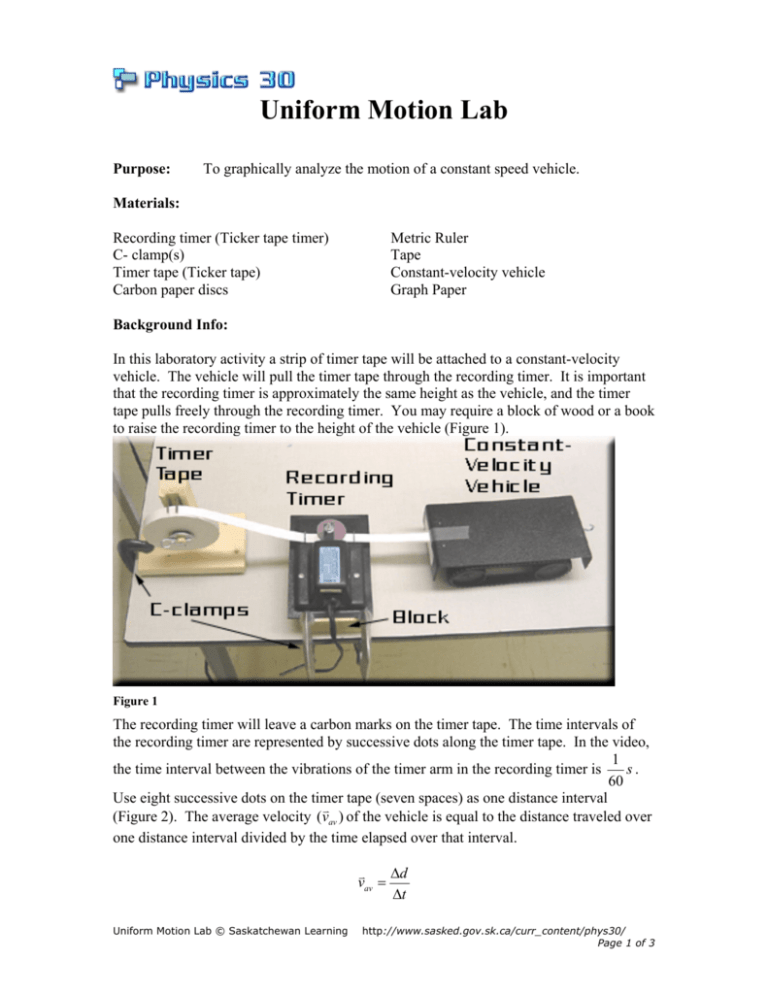
Uniform Motion Lab Purpose: To graphically analyze the motion of a constant speed vehicle. Materials: Recording timer (Ticker tape timer) C- clamp(s) Timer tape (Ticker tape) Carbon paper discs Metric Ruler Tape Constant-velocity vehicle Graph Paper Background Info: In this laboratory activity a strip of timer tape will be attached to a constant-velocity vehicle. The vehicle will pull the timer tape through the recording timer. It is important that the recording timer is approximately the same height as the vehicle, and the timer tape pulls freely through the recording timer. You may require a block of wood or a book to raise the recording timer to the height of the vehicle (Figure 1). Figure 1 The recording timer will leave a carbon marks on the timer tape. The time intervals of the recording timer are represented by successive dots along the timer tape. In the video, 1 the time interval between the vibrations of the timer arm in the recording timer is s. 60 Use eight successive dots on the timer tape (seven spaces) as one distance interval v (Figure 2). The average velocity (vav ) of the vehicle is equal to the distance traveled over one distance interval divided by the time elapsed over that interval. ∆d v vav = ∆t Uniform Motion Lab © Saskatchewan Learning http://www.sasked.gov.sk.ca/curr_content/phys30/ Page 1 of 3 Figure 2 Procedure: 1. 2. 3. 4. 5. 6. 7. Watch the video. Print off the ticker tape file. “Start” has been written on the end of the ticker tape that was attached to the vehicle. Some of the dots at the start of the tape are crowded, select the first dot that is distinguished from all of the initial dots, mark this dot as “0”. Count off eight more dots, mark this dot as “1”. These numbers represent the distance traveled by the vehicle over an elapsed period of time. Measure the distance in centimeters between dot ‘0” and dot “1”. Record this in Table 1 as the displacement for distance interval 1. Measure the successive distance intervals recording the displacements in the table. Calculate the actual time that has elapsed over one distance interval. This time interval will be the same for each distance interval. v Calculate the average velocity (vav ) in cm/s. Record each average velocity in the respective distance interval in Table 1. Keep a running sum of all the displacements in the total displacement column in Table 1. (e.g. Total displacement in Distance Interval 1, is the same as the displacement, the total displacement in Distance Interval 2 is the sum of the displacements of Distance Interval 1 and Distance Interval 2.) Data & Analysis: Table 1: Distance Interval 1 2 3 4 5 6 7 8 9 10 Displacement (cm) Uniform Motion Lab © Saskatchewan Learning Average Velocity (cm/s) Total Displacement (cm) http://www.sasked.gov.sk.ca/curr_content/phys30/ Page 2 of 3 1. 2. 3. 4. 5. 6. 7. 8. Create a velocity versus time graph. Make sure that you properly label the graph (Consult the How to Graph Tutorial). In the graph above which is the independent and dependent variable? Indicate on the above graph areas where the velocity is constant or changing. Calculate the area under the graph. What does the area represent? Calculate the vehicle’s average velocity for the entire trip. Draw a line on your graph using a different color to indicate the average velocity. Create a total displacement versus time graph. Use the same time scale as you did in the velocity versus time graph. Explain what the graph shows. What does the slope of the line represent; point out any changes in the slope on the graph. Explain the correlation of shape between the first and second graph. Conclusion: 1. 2. Calculate the percent difference between the area calculated under the velocity versus time graph and the total displacement. theoretical value − exp erimental value Percent Difference = x100 theoretical value Explain the percent difference. Uniform Motion Lab © Saskatchewan Learning http://www.sasked.gov.sk.ca/curr_content/phys30/ Page 3 of 3

